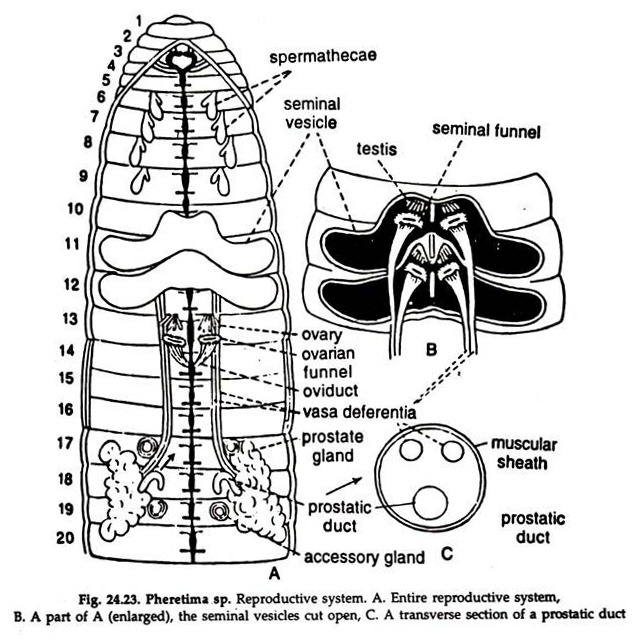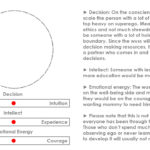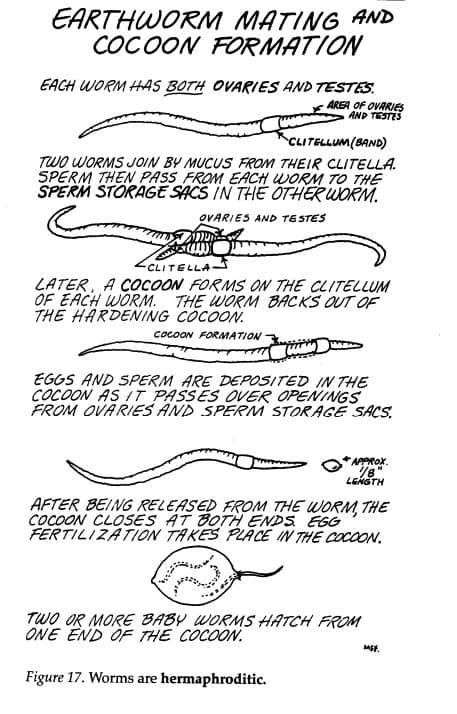
Earthworm Mating and Cocoon Formation
Each worm has both ovaries and testes.
Two worms join by mucus from their clitella.
During mating two individuals place themselves against each other in a head-to- tail position.
The male genital aperture of one is placed against the spermathecal pore of the other.
A mutual exchange of sperms and a certain amount of prostatic fluid take place.
Sperm then pass from each worm to the sperm storage sacks in the other worm.
Later, a cocoon forms on the clitellum of each worm. The worm back out of the hardening cocoon.
Eggs and sperm are deposited in the cocoon as it passes over openings from ovaries and sperm storage sacs.
After being relased from the worm, the cocoon closes at both ends. Egg fertilisation takes place in the cocoon.
Two or more baby worms hatch from one end of the cocoon.
Worms are hermaphroditic – all worms have both sexes.
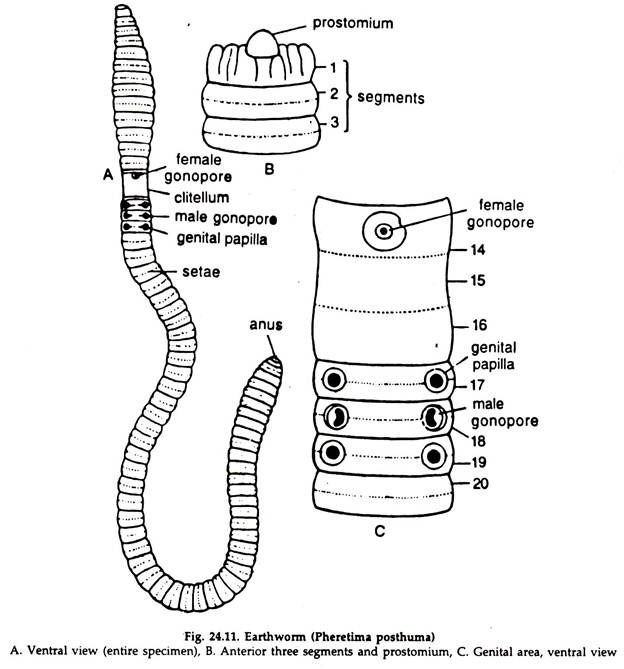

The Digestive System
Mouth: The ventral mouth is crescent- shaped, situated in the peristomium. It is followed by a small buccal cavity, opening into the pharynx.
Pharynx: The thick-walled, pear-shaped, muscular structure in the 3-4 segments. A pharyngeal bulb is present on the dorsal wall.
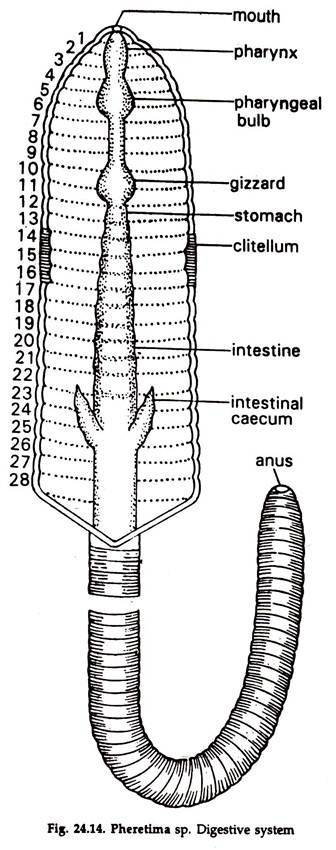
Oesophagus: The muscular tube, extending from 5-8 segment and connects the pharynx with the stomach. The posterior part of the oesophagus is thick-walled, muscular with an inner, cuticular lining, oval in shape and known as gizzard.
Gizzard: The food matters are grind to fine particles in it. It is a hard, muscular structure lined internally by a tough cuticle.
Stomach: It is highly vascular, glandular, lies in 9-14 segments and continues posteriorly as intestine.
Intestine: A thin walled, somewhat wide tube, running up to the anus in the last segment.
Intestinal coeca: A pair of small, conical outgrowths, directed anteriorly, project from the sides of the intestine in the 26 segment.
Earthworm obtains organic materials from the soil it swallow, rejecting the rest as cast. It also feeds upon decaying matters, small dead animals, etc. The mouth and pharynx help in feeding. In the pharynx mucin and proteolytic enzymes are secreted.
Mucin lubricates the food and digestion of protein starts. The gizzard grinds the food to fine particles and digestion is completed in the stomach with the help of enzymes secreted there. Absorption occurs in the intestine.

The Reproductive System
Male Reproductive System:
1. The male reproductive organs consist of two pairs of testes, two pairs of vasa deferentia with seminal funnels, two pairs of seminal vesicles, a pair of prostate glands with ducts and a pair of genital apertures (Fig. 24. 23A, B).
2. The testes are two pairs. They are small, white bodies composed of five to eight digitate processes coming out from a narrow base and are placed close to the middle line in the 10 and 11 segments.
3. A ciliated funnel, the seminal funnel is present just behind each testis and two pairs of funnels are present.
4. Each pair of testes and the respective seminal funnels are enclosed in a bilobed testis sac which continues behind into a seminal vesicle.
5. Each funnel leads posteriorly into a vas deferens and the two vasa deferentia of the side run backward up to the 18 segment.
6. A pair of white prostate glands, irregular in outline is present in the 16 to 22 segmental regions.
From each gland arises a duct, which is joined by the two vasa deferentia of the side and the three ducts are surrounded by a thick muscular sheath. This common structure is known as the prostatic duct. (Fig. 24.23C). All the three ducts, however, rim separately all along, and also open to the exterior separately through the male genital aperture situated on the ventral surface of the 18 segment.
7. Spermatozoa budded in the testes mature in the seminal vesicles and pass to the exterior through the vasa deferentia.

Female Reproductive System:
1. The female reproductive organs consist of a pair of ovaries, a pair of oviducts, a female gonopore and four pairs of spermathecae. (Fig. 24.23A).
2. Ovaries are white bodies attached to the posterior face of the septum between the 12 and 13 segments. They resemble the testes very closely excepting the distal digitate processes, which are rather long. (Fig. 24.24).
3. Just behind each ovary is a ciliated funnel, the oviducal funnel, which ends in the oviduct. The two oviducts open externally by a common aperture placed on the ventral surface of the 14 segment.
4. Ova budded in the ovaries are shed in the coelom and being collected by the oviducal funnels pass to the exterior through the oviducts.
5. Spermatheca is a flask-shaped sac with an anterior blind diverticulum and opens to the exterior by a narrow duct. Sperms received from other partner during mating are stored up temporarily in these diverticula. Four pairs of spermathecae, one pair in each of the 6, 7, 8 and 9 segments are present.
Must Watch Earthworm Love is Cuddly … and Complicated